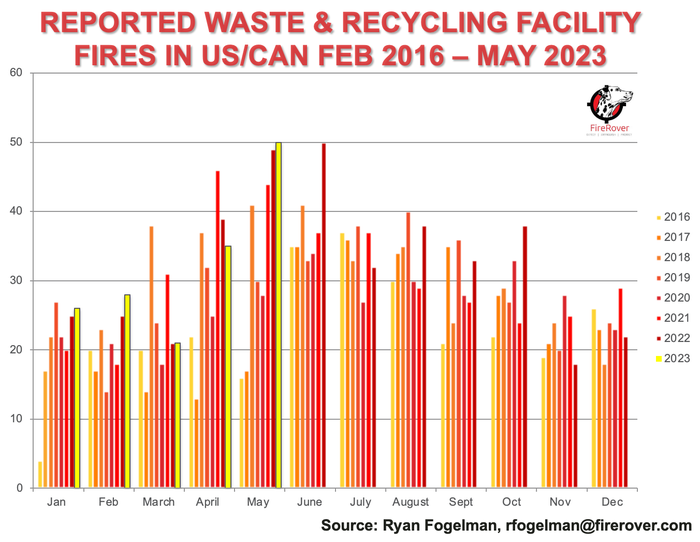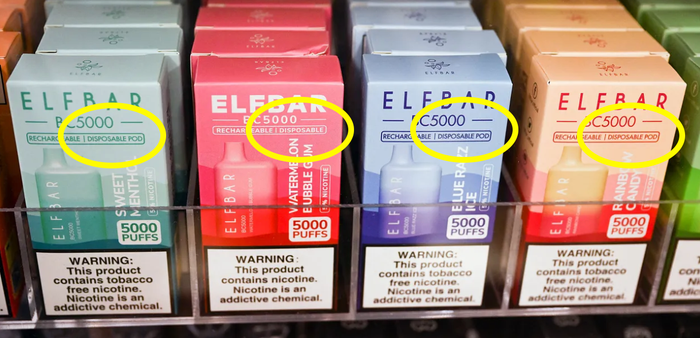Summertime Spike Rears Its Ugly Head with Highest Reported Fires on Record
Summertime is nearly here. As we defrost from the cold winter and mild April, May’s heat and dryness have officially caused the summertime spike to start earlier than historically expected but stays true to the past two years.

Summertime is nearly here. As we defrost from the cold winter and mild April, May’s heat and dryness have officially caused the summertime spike to start earlier than historically expected but stays true to the past two years.
Coming off a record year for reported fires at our waste and recycling facilities, as highlighted in my recently released annual report, "Waste & Recycling Facility Fires Annual Report," the first five months of 2023 are looking to be on trend to beat, or at least mimic, last year’s increasing fire hazard at our operations in U.S. and Canada.

May 2023 Fire Data
In May, we hit June of last year's historic high of 50 reported fire incidents that occurred at our waste and recycling facilities. Of those fire incidents, 31 occurred in waste, paper and plastic facilities, 14 occurred at scrap metal recycling facilities, two occurred at both organics and rubber recycling facilities and one each occurred at construction and demolition and hazmat recycling facilities. At Fire Rover, we had an extremely busy month, responding to more than 400 hot spots and/or fire incidents at our clients’ facilities.
Being five months into 2023, we are at a time where we can start to understand where we are trending from a historical perspective. Looking at May, 50 incidents seem high when comparing it to May’s historical average of 35 fire incidents experienced since 2016. Could May be an aberration? Of course. There are one-off “bad” or “good” months, so I put together the following graph to try and understand where we sit and what we can expect for the rest of 2023.

If you compare 2023 with previous years, not only is May’s 50 fires high from a monthly perspective, but February’s month-high and January's second-highest month start to form an interesting trend. It is true that we had a bit of a reprieve in March and April when compared to previous years. When comparing year-to-date incident data, 2023 is coming in at only second to 2018, which was the first time we as an industry truly experienced the first big wave of lithium-ion batteries hitting our waste and recycling streams on a global scale.
Although 2018, the January-May data (160) was higher when compared to the January-May of 2022 (159). We ended 2018 with 365 total fire incidents, a record at the time, but well eclipsed by last year’s annual total of 390 fire incidents. By this time last year, we had experienced 159 fire incidents compared to 160 this year.
How will the year end up? Last year, June was the worst June we had experienced by almost 10 more incidents than the worst prior month we had experienced in June 2018. June of this year will be extremely telling for how the rest of the year will turn out, but time will tell.
What in the World is Going on with Vapes?
Just like many of our clients, I spend a ton of time trying to understand what is going on in our waste stream. We hear the term “lithium-ion batteries” thrown around, but most folks do not understand battery chemistry or what is doing the charging; they understand the product by its utility. For example, a vape is not a personal electronic but something used to get nicotine into your system, similar to a cigarette from an economic alternative perspective.
Watch the video below of an influencer who is quitting smoking. He is not deliberately trying to inundate his trash with batteries; he is doing what millions of folks around the globe have done hundreds of thousands of times: quitting smoking by removing ALL the products from their household in order to “white knuckle” it through addiction.
Watch as he throws away handfuls of vapes. Not only does he throw them away, but he places them into the water. I would assume this is so they cannot be used, but he certainly has no idea these are electronic with fuel inside them that can ignite and burn. Similar to the dangers traditional cigarettes used to pose. Everyone knew, or at least should have known, that cigarettes or matches used to light them have the potential for danger. I have heard fewer and fewer stories of fires in recycling facilities that operators believe started from a still-lit cigarette butt, but vapes have some of these risks, too. If one of these vapes catches fire or explodes, it is dangerous, even more so when the fire lights around another accelerant, gas or worse.
According to an article in The Bureau of Investigative Journalism, “Five disposable vapes are being thrown away every second by young people in the U.S. despite the devices containing reusable lithium-ion batteries. Over a year, this amounts to 150 million devices.” This article was using the data to show how much lithium is wasted—enough to power 6,000 Teslas—but what it’s missing is those 150 million devices, which in my opinion is a very conservative number, are ending up in our waste bins, scraped cars, demolished buildings and elsewhere.
In the same article, “The Environmental Protection Agency (EPA) told the Bureau that vapes are being incorrectly discarded in household trash because they are often branded as ‘disposable.’ This leads to the entire device, including its battery, being thrown away in household trash. Despite this, it is perfectly legal to dump these batteries in the household trash in the U.S.”

Am I saying we should ban vapes from being thrown in the trash? Maybe, especially if done purposely by a business or in large quantities. But I would be assuming that policing the policy would be difficult and probably not do much good. I would be open to a deposit program, which isn’t a bad idea as it has worked relatively well with taxing our other vices that gives it a value. I would rather have one of these get collected and returned for a quarter than have another hazard to deal with in our waste and recycling streams. We should stop the manufacturers of vapes from saying they are “single use” or “disposable.” We need to make it clear to consumers these are not disposable, can be recycled and, most importantly, set up convenient and safe ways to properly collect and recycle them.
Conclusion
In my opinion, the main driver of the increase in reported fire incidents that culminate into the “summertime spike” in fires is annual spring cleaning and house projects. As we continue to enjoy the warmer months, we need to be vigilant not to take the easy way out and toss hazardous items such as fertilizers, pool chemicals, barbeque hot ashes, fireworks, paint thinners and more in our curbside bin and watch it disappear because these hazards, not just lithium-ion batteries, are still responsible for 50% of the fire incidents we experience in our waste and recycling facilities on an annual basis.
As I highlighted in my "6th Annual Waste & Recycling Facility Fires Annual Report," lithium-ion batteries and the other traditional fire hazards are responsible for $2.5 billion dollars in damage, unfairly paid by the waste and recycling operators, their insurance companies and the fire professionals who have to fight these fires. So, let’s work together to move the needle on safety and reduce the number of fire incidents in our facilities.
Ryan Fogelman, JD/MBA, is vice president of strategic partnerships for Fire Rover. He is focused on bringing innovative safety solutions to market, and two of his solutions have won the distinguished Edison Innovation Award for Industrial Safety and Consumer Products. He has been compiling and publishing the “Reported Waste & Recycling Facility Fires In The US/CAN” since February 2016 and the “Waste & Recycling Facility Fires Annual Report.” Fogelman regularly speaks on the topic of the scope of fire problems facing the waste and recycling industries, early detection solutions, proper fire planning and early-stage fire risk mitigation. Additionally, Fogelman is on the National Fire Protection Association’s Technical Committee for Hazard Materials. (Connect with Ryan on LinkedIn at https://www.linkedin.com/in/ryanjayfogelman or email at [email protected])
About the Author
You May Also Like




.png?width=300&auto=webp&quality=80&disable=upscale)